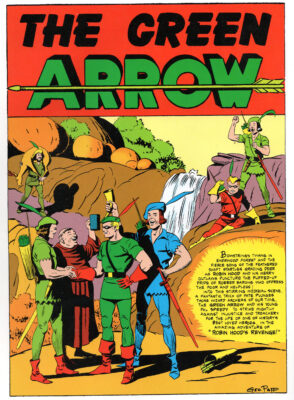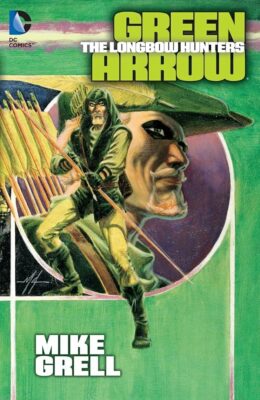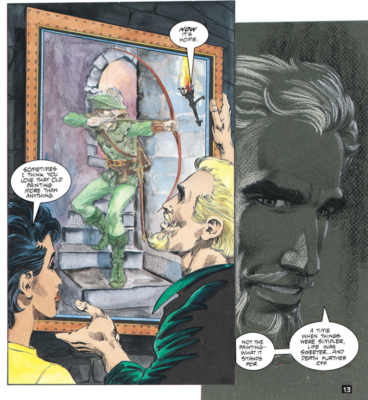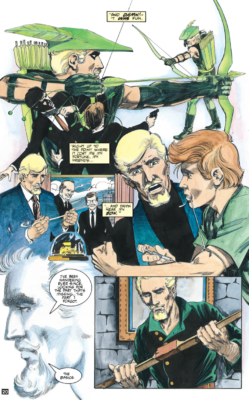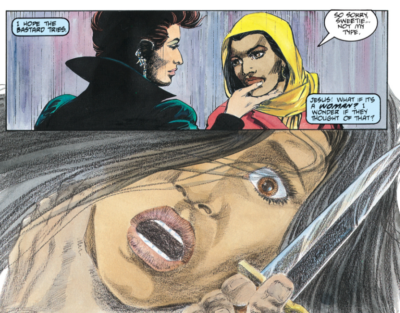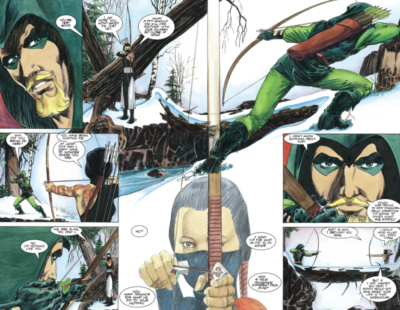Changes and Reflections in Green Arrow: The Longbow Hunters By Anthony M. Caro
Is there anything wrong with being a derivative character if the creative team crafts a derivative and self-actualized one?
Not if you look at the overall legacy and contributions of Green Arrow to DC Comics’ history.
Green Arrow’s life in print took a surprising turn in the 1980s. The original incarnation of Green Arrow – a Robin Hood clone/blatant Batman rip-off mashup – debuted in the Golden Age heroes and hung around for years as a B-grade character. Years of deserved middling popularity resulted from camp-inspired silliness. Giving the hero gimmicks such as an arrow with a boxing glove tip designed to knock out villains would hardly drive serious reader interest.
Green Arrow’s hobbling lameness had one saving grace – it begged for improvement. Improvements eventually arrived in overachievement form. Comic book publishers of generations past preferred to avoid tinkering too much with characters that sold well, but they had little to lose by experimenting with B and C-level heroes. Denny O’Neil and Neal Adams did an incredible job reinventing Green Arrow after teaming him up with Green Lantern in the classic “Hard-Traveling Heroes” tales.
More than 15 years had passed after those classic stories first hit newsstands to tepid sales before DC Comics opted to take another risky chance with Green Arrow. and – ironically – once again ride Batman’s cape-tails after the success of The Dark Knight Returns (February to June 1986) by putting Green Arrow in a three-part miniseries that delved deeply into the character under the hood.
True, Green Arrow, the hero, had limitations. However, Oliver Queen, the alter-ego behind the minute green mask, had far more potential than realized. Green Arrow: The Longbow Hunters (August to October 1987) is far more an Oliver Queen tale than a Green Arrow adventure.
Green Arrow stories often faced a creative ceiling. How much can you do with a heroic archer lacking over-the-top abilities? Little. Unless the creators looked outside the comic book panel box.
Shifting to stories focused on an aging Oliver Queen, a conflicted man struggling with a mid-life crisis, offered incredible potential that his masked alter ego lacked. Mike Grell saw that potential and crafted one of the most brilliant miniseries published during the onset of the continually shifting “modern” age.
An Alter Ego’s Conflict
Early in the first issue of The Longbow Hunters, Oliver Queen laments “losing his edge” because he relied on “trick arrows.” Moreso, the trick arrows made him a lazy man-child. Queen admits he based “Green Arrow” on Robin Hood because he loved the classic Hollywood films as a child. Green Arrow, the hero, represents little more than a grown man cosplaying Robin Hood with the trick arrows reflecting a refusal to grow up.
Like so many superheroes and villains, Oliver Queen appreciates the silly outfit and minute mask because they allow him to become another person while not having to accept the responsibilities of living his real life. Battling the bad guys becomes a convenient excuse to escape from the world. Why deal with mundane duties when there’s a city – or a world – to save?
The more time he spends defeating villains while dressed as Green Arrow, the man under the hood and behind the mask avoids reflecting on Oliver Queen’s life’s failures.
Those failures haunt him at night when the hood and mask come off.
One day, the man wakes up at age 43 and realizes he’s spent so much time as Green Arrow that Oliver Queen became an afterthought. Green Arrow provided a perfect escape from the world. Still, Oliver Queen – unlike so many of his super-powered colleagues – understands the value of being a genuine person and not a made-up character. Green Arrow’s distant second-tier status in the DC Comics universe forces Queen’s realizations. Green Arrow doesn’t receive the attention and adulation to lull Oliver Queen to make excuses to remain hiding behind a public persona and false identity.
The lack of adulation is a blessing. Oliver Queen gains the late-in-life self-reflection to understand there’s no such person or alter ego as Green Arrow. He’s just Oliver Queen dressed as Robin Hood.
The Heroic-But-Ignoble Struggle
“The Emerald Archer” lacked the popularity for Queen to appreciate his escapism. As a dejected autograph seeker once asked Aquaman, “How’s it like to be nobody’s favorite hero?” Only second and third-tier characters understand how much that truism nags at them. It’s not enjoyable to be the perennial guest star and understudy.
A conflicted Oliver Queen lost his whimsy about being Green Arrow but still intends to use his archery and combative skills to right wrongs. He’s done it for so long that he might as well embrace his pursuits. Where else can he go? Troubled as the confused archer might be, Oliver Queen is a hero in heart and action. But he’s no longer comfortable in the role of a fantasy superhero. Moving him to Seattle and away from fellow heroes and de-emphasizing the Green Arrow identity underscores that Oliver Queen moved out of the DC Comics universe. He’s a man alone who stands alone. (Except when he needs Black Canary’s assistance – hero-wise and emotionally.)
When Oliver Queen tells his origin tale to Dinah Lance/Black Canary, he recounts how he fell off a yacht, washed ashore on a deserted island, made a bow and arrow, and hunted prey for food. Queen notes that his time on the island represented a primal return to human basics. He hunted for survival and became a proficient longbow hunter. Queen felt he had no connection to those who hunt for fun because hunting is a serious business.
After leaving the island, Queen becomes a media sensation upon donning the absurd Green Arrow costume. The wealthy and bored Oliver Queen finds life as Green Arrow fun. As he grew older, Queen realized the “escapist fun” of becoming Green Arrow turned him into an unserious man.
Now, a more driven Oliver Queen tries to find himself by hunting down a twisted serial killer running amok in Seattle. While Queen wears the traditional Green Arrow costume, he seems to do so out of habit.
It’s a habit Oliver Queen must break.
Green Arrow No More
Oliver Queen never throws away the Green Arrow costume, but he’s not Green Arrow anymore. He wears the costume out of necessity – superheroes strike fear in bad guys, and Queen won’t give up his edge. The so-called “Emerald Archer” is not looking to hide behind an alter ego. He’s just going with the superhero flow by donning the green tights.
Batman’s suffers a paradoxical lament. Bruce Wayne spends so little time being Bruce Wayne that the Batman persona takes over. Bruce Wayne is himself when he wears the cape and cowl. The alter ego, “Billionaire Bruce Wayne,” is a fictitious role that Batman plays.
Oliver Queen caught himself late in life – or perhaps maturity helped him see the way – and knew it was time to stop playing the role of the Green Arrow persona while getting a hero’s work done. Except it’s not Green Arrow’s work; it’s Oliver Queen’s quest for meaning.
There’s more to throwing away the trick arrows than creating an edgier story. It’s symbolic of a man drifting away from who he is, re-anchoring himself back to who he was. Except he’s not who he was – the pre-archer Oliver Queen was a playboy adrift. Green Arrow gave him purpose, but that purpose morphed into a bad guy-battling live-action role-player. Oliver Queen took the role too far for too long.
Oliver Queen knew he had more purpose in life than the role he chose to play.
Yes, there’s a serial killer on the loose. And there’s a convoluted plot about the deaths of several old, wealthy World War II veterans with mysterious backgrounds. Don’t overlook the amoral archer, Shado, who kills her victims in wanton vigilante abandon.
All the narrative-driven intrigue serves as a backdrop to Oliver Queen’s mid-life crises and re-awakening.
What does Black Canary say to him during his attempts at normal life grounding?
I love you, Oliver, and I’d love to make babies with you. But I won’t make orphans. Could any other words snap an aging man into realizing his mortality? And what does Oliver Queen truly want at this stage in his life?
Like so many heroes, Oliver Queen must put on the costume to step outside himself and embrace a different persona to serve the greater good. That’s easy when you’re a teenage Peter Parker, but not so easy when there are more years behind a life than ahead. Oliver Queen only has so many arrows left.
Being Green Arrow and the superhero live-action role-playing that goes with the characters seems wonderful when young, wealthy, and wish to cast away life’s responsibilities by hiding inside a gaudy green costume – until the years pass and you wake up and look in the mirror and see Oliver Queen, the man, a man who knows he overlooked so many aspects of his life for so many years.
What did Shado’s mentor tell her many years ago?
You can’t let go of the arrow until you let go of yourself.
Oliver Queen has to let go of himself, and “himself” is the fake persona of Green Arrow. Oliver Queen must become himself again and let go of the Green Arrow character. The process starts with the realizations in The Longbow Hunters.
Change Means Accepting
Give the man his due. Green Arrow might be a weak Batman rip-off, but Oliver Queen has more self-honesty than Bruce Wayne.
At the conclusion of Knightfall, Batman’s words to a fallen Azrael reflect a promise that the Dark Knight will spend less time being a masked hero and more time being Bruce Wayne. Batman never fulfilled the promise.
Serving as a B-level character involved in less serious adventures than Batman or Superman, it may be easier for Oliver Queen to start to turn away from the Green Arrow persona. He’s conflicted because he’s moving on in years, but Oliver Queen’s physically more fit than someone his age, and mentally, he’s more mature than someone much younger.
While the underlying complex narrative and subplots involve CIA corruption and the Yakuza’s desire for revenge, the plot takes a step back to the character development, a welcome change in comics.
Mike Grell literally and figuratively drives the point home when Oliver Queen kills a psychopath torturing Black Canary to death. Soon after, Queen faces off against fellow longbow hunter Shado, and she asks him if he could have wounded the maniac rather than kill him. Both she and Queen know the answer.
What does Shado say to Oliver Queen during a standoff?
I once said you haven’t the eyes of a killer. They changed as have you. You can never go back.
No, Oliver Queen can never go back to ridiculous arrows with boxing gloves in the end. Nor can he return to embracing the initially wayward shadow persona of Green Arrow. He has to become Oliver Queen and stop running and hiding from who he is.
Oliver Queen’s not giving up on the crime-fighting, though. He’s invested too much of his time has been invested in fighting crime. Oliver Queen will continue that path more as Oliver Queen than a mythic hero.
Continue he does, the monthly Green Arrow series Mike Grell spearheaded in the wake of The Longbow Hunters’ success. The three-part mini-series launched an impressive new era for Green Arrow, and Grell’s future virtuoso work continued to reap acclaim and Oliver Queen continued to embrace himself.
Anthony M. Caro recently published the acclaimed work Tragedy Man: A Horror Anthology. He also penned the essay collection Universal Monsters and Neurotics: Children of the Night and their Hang-Ups and the sci-fi novelette Why Is Cal Drawing Stick Figures at 3 AM in the 22nd Century? He writes about all things pop culture and contributed to HorrorNews.Net, PopMatters, Mad Scientist, and Jiu-Jitsu Times. Besides working as a professional writer, he handled production duties in radio, TV, film, and theater.
essay ©2023 Anthony Caro
Join us for more discussion at our Facebook group
check out our CBH documentary videos on our CBH Youtube Channel
get some historic comic book shirts, pillows, etc at CBH Merchandise
check out our CBH Podcast available on Apple Podcasts, Google PlayerFM and Stitcher.
Use of images are not intended to infringe on copyright, but merely used for academic purpose.
Images used ©Their Respective Copyright Holders








